Development of V-Shaped Beam on the Shock Resistance and Driving Frequency of Micro Quartz Tuning Forks Resonant Gyroscope
Abstract
:1. Introduction
2. Working Principle and Fabrication Process of the Gyroscope
2.1. The Working Principle of the Gyroscope
2.2. Fabrication Process
3. Analysis of Impact Response Characteristics of Micro-machined Gyroscope
4. Theory of Shock Test
5. Modal Analysis of the Tuning Forks Structures
6. Modeling, Simulation and Analysis
6.1. Modeling of MEMS Quartz Tuning Forks Resonant Gyroscope
6.2. Simulation and Analysis
6.2.1. Transient Dynamics Simulation
6.2.2. Shock Spectrum Analysis
7. Test and Experiment
8. Conclusions
Author Contributions
Funding
Acknowledgments
Conflicts of Interest
References
- Huang, H.; Chen, X.; Zhang, B.; Wang, J. High accuracy navigation information estimation for inertial system using the multi-model EKF fusing adams explicit formula applied to underwater gliders. ISA Trans. 2017, 66, 414–424. [Google Scholar] [CrossRef] [PubMed]
- Zaman, M.F.; Sharma, A.; Hao, Z.; Ayazi, F. A mode-matched silicon-yaw tuning-fork gyroscope with subdegree-per-hour Allan deviation bias instability. J. Microelectromech. Syst. 2008, 17, 1526–1536. [Google Scholar] [CrossRef]
- Xu, Y.; Chen, X.Y.; Wang, Y.M. Two-mode navigation method for low-cost inertial measurement unit-based indoor pedestrian navigation. Simul. Trans. Soc. Model. Simul. Int. 2016, 92, 839–848. [Google Scholar] [CrossRef]
- Shaeffer, D.K. MEMS inertial sensors: A tutorial overview. IEEE Commun. Mag. 2013, 51, 100–109. [Google Scholar] [CrossRef]
- Shao, P.; Mayberry, C.L.; Gao, X.; Tavassoli, V.; Ayazi, F. A polysilicon microhemispherical resonating gyroscope. J. Microelectromechan. Syst. 2014, 23, 762–764. [Google Scholar] [CrossRef]
- Fang, J.C.; Qin, J. Advances in atomic gyroscopes: A view from inertial navigation applications. Sensors 2012, 12, 6331–6346. [Google Scholar] [CrossRef]
- Microcomponents SA. Available online: https://tel.search.ch/grenchen/oelirain-5/microcomponents-sa (accessed on 6 August 2018).
- Solid State Angular Rate Gyro. Available online: https://watson-gyro.com/wp-content/uploads/delightful-downloads/2019/05/ARS-G152_spec.pdf (accessed on 29 October 2020).
- Solid State Vertical Reference. Available online: https://watson-gyro.com/wp-content/uploads/delightful-downloads/2015/06/vertical-gyro-ADS-spec.pdf (accessed on 29 October 2020).
- Nonomura, Y.; Fujiyoshi, M.; Omura, Y.; Tsukada, K.; Okuwa, M.; Morikawa, T.; Sugitani, N.; Satou, S.; Kurata, N.; Matsushige, S. Quartz rate gyro sensor for automotive control. Sensors Actuators A Phys. 2004, 110, 136–141. [Google Scholar] [CrossRef]
- Madni, A.M.; Wan, L.A.; Hammons, S. Microelectromechanical quartz rotational rate sensor for inertial applications. In Proceedings of the IEEE Aerospace Applications Conference, Aspen, CO, USA, 10 February 1996. [Google Scholar]
- Jaffe, R.; Simshauser, S.; Madni, A.M. Quartz Dual Axis Rate Sensor (QDARS). In Proceedings of the Record—IEEE PLANS, Position Location and Navigation Symposium, San Diego, CA, USA, 25–27 April 2006. [Google Scholar]
- Madni, A.M.; Costlow, L.E. A third generation, highly monitored, micromachined quartz rate sensor for safety-critical vehicle stability control. In Proceedings of the IEEE Aerospace Conference, Big Sky, MT, USA, 10–17 March 2001. [Google Scholar]
- QRS14. Available online: https://emcore.com/wp-content/uploads/2019/11/964117_P-QRS14.pdf (accessed on 29 October 2020).
- SDG1400. Available online: https://emcore.com/wp-content/uploads/2019/11/965994_E_SDG1400-200-200.pdf (accessed on 29 October 2020).
- QRS116. Available online: https://emcore.com/wp-content/uploads/2019/11/965583_M-QRS116.pdf (accessed on 29 October 2020).
- Hokka, J.; Raami, J.; Hyvönen, H.; Broas, M.; Makkonen, J.; Li, J.; Mattila, T.T.; Paulasto-Kröckel, M. Methods for reliability assessment of MEMS devices—Case studies of a MEMS microphone and a 3-axis MEMS gyroscope. In Proceedings of the Electronic Components and Technology Conference, San Diego, CA, USA, 29 May–1 June 2012. [Google Scholar]
- Makkonen, J.; Broas, M.; Li, J.; Hokka, J.; Mattila, T.T.; Paulasto-Kröckel, M. Reliability assessment of MEMS devices—A case study of a 3 axis Gyroscope. In Proceedings of the 2012 4th Electronic System-Integration Technology Conference, ESTC 2012, Amsterdam, The Netherlands, 17–20 September 2012. [Google Scholar]
- Li, J.; Broas, M.; Makkonen, J.; Mattila, T.T.; Hokka, J.; Paulasto-Kröckel, M. Shock impact reliability and failure analysis of a three-axis MEMS gyroscope. J. Microelectromechan. Syst. 2014, 23, 347–355. [Google Scholar] [CrossRef]
- Srikar, V.T.; Senturia, S.D. The reliability of microelectromechanical systems (MEMS) in shock environments. J. Microelectromechan. Syst. 2002, 11, 206–214. [Google Scholar] [CrossRef]
- Zhang, J.H.; Li, D.-G.; Cui, X.-J. Failure analysis of microstructure under shock load. In Proceedings of the IEEE International Conference on Modelling, Wuhan, China, 24–26 June 2012. [Google Scholar]
- Ramini, A.H. The Dynamics of Microstructures under Shock and Acceleration; Binghamton University: New York, NY, USA, 2012. [Google Scholar]
- Younis, M.I. MEMS Linear and Nonlinear Statics and Dynamics; Springer Science & Business Media: Berlin, Germany, 2011; ISBN 978-1-4419-6019-1. [Google Scholar]
- Li, J.; Mattila, T.; Vuorinen, V. MEMS Reliability. In Handbook of Silicon Based MEMS Materials and Technologies, 2nd ed.; Elsevier: Amsterdam, The Netherlands, 2015; ISBN 9780323312233. [Google Scholar]
- International Electrotechnical Commission (IEC). Environmental Testing—Part 2-27: Tests—Test Ea and Guidance: Shock; International Electrotechnical Commission: Geneva, Switzerland, 2008. [Google Scholar]
- Paszkowicz, W.; Podsiadło, S.; Minikayev, R. Standards on Piezoelectric Crystals, 1949. Proc. IRE 1949, 37, 1378–1395. [Google Scholar] [CrossRef]
- Chao, H.L.; Parker, T.E. Tensile Fracture Strength of St Cut Quartz. In Proceedings of the the Annual IEEE International Frequency Control Symposium, Philadelphia, PA, USA, 1–3 June 1983. [Google Scholar]
- Karrer, H.E.; Leach, J. A Quartz Resonator Pressure Transducer. IEEE Trans. Ind. Electron. Control Instrum. 1969, 1, 44–50. [Google Scholar] [CrossRef]
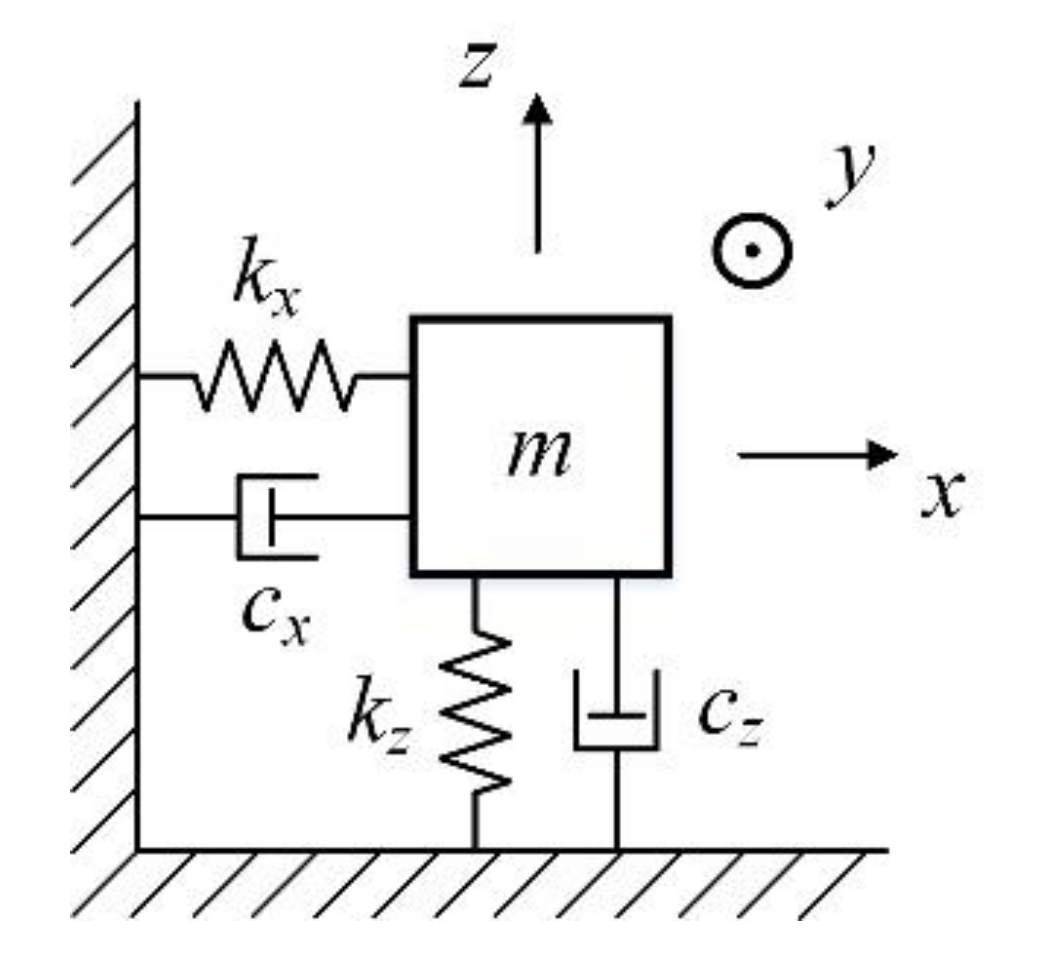
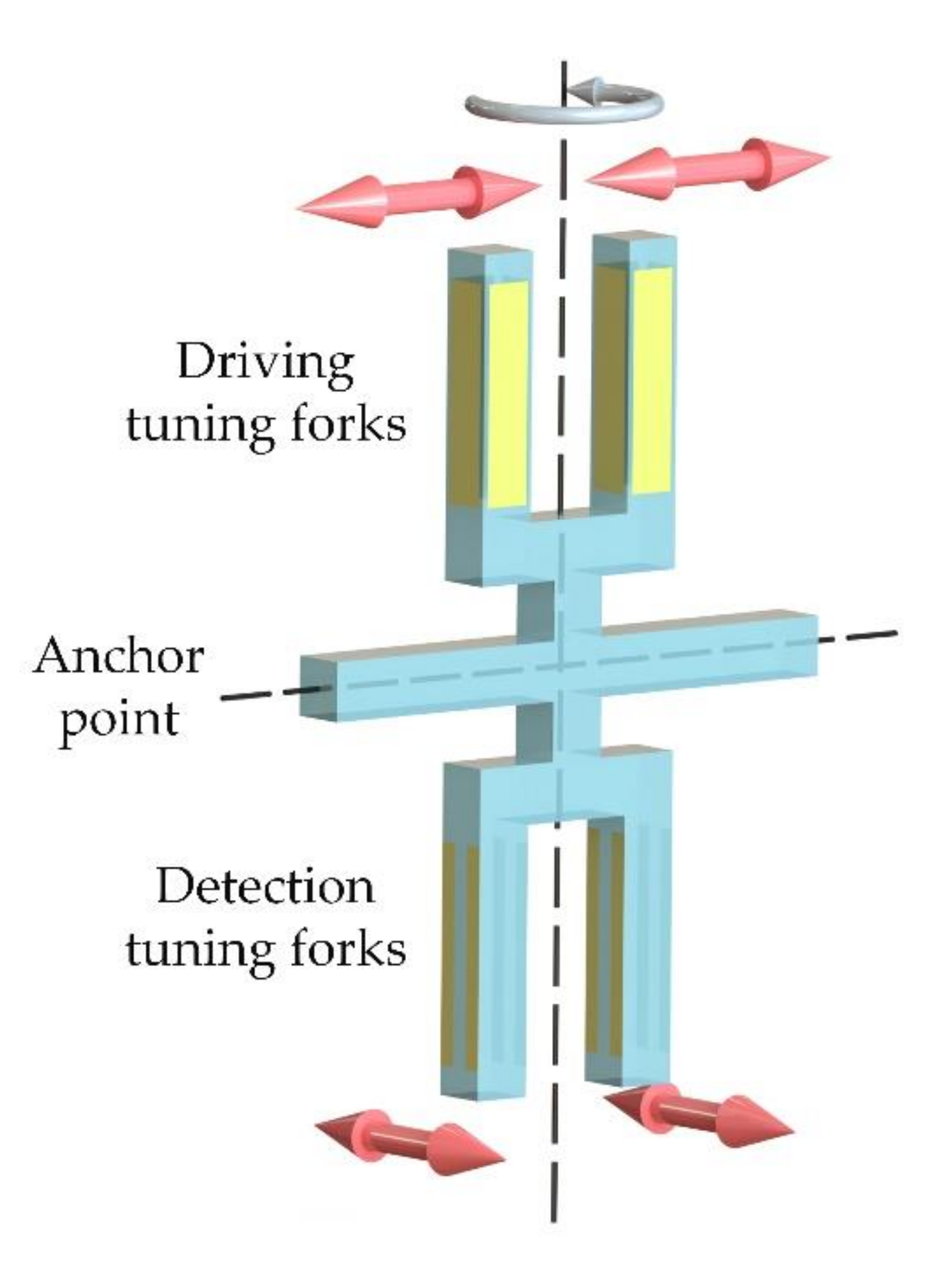
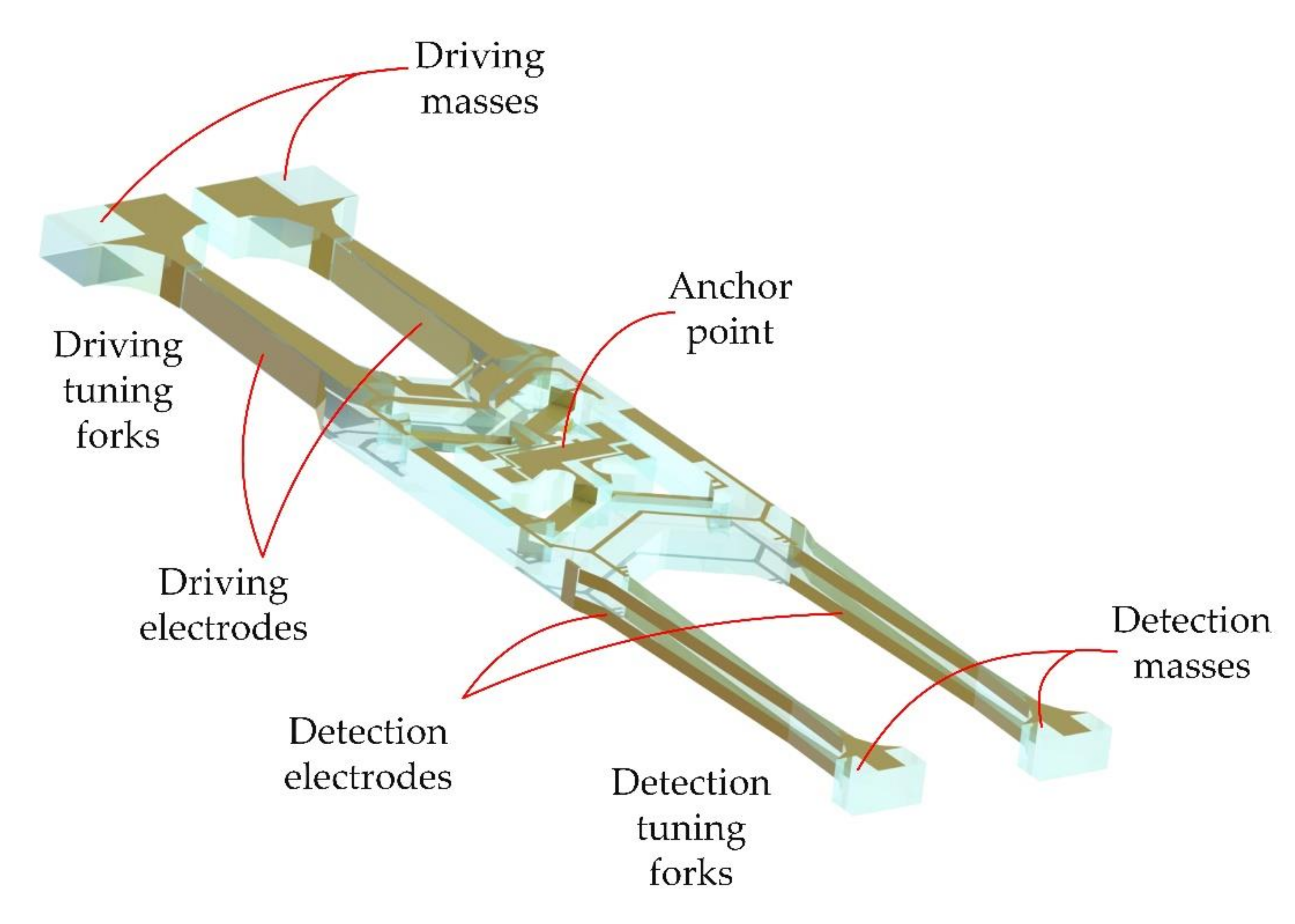

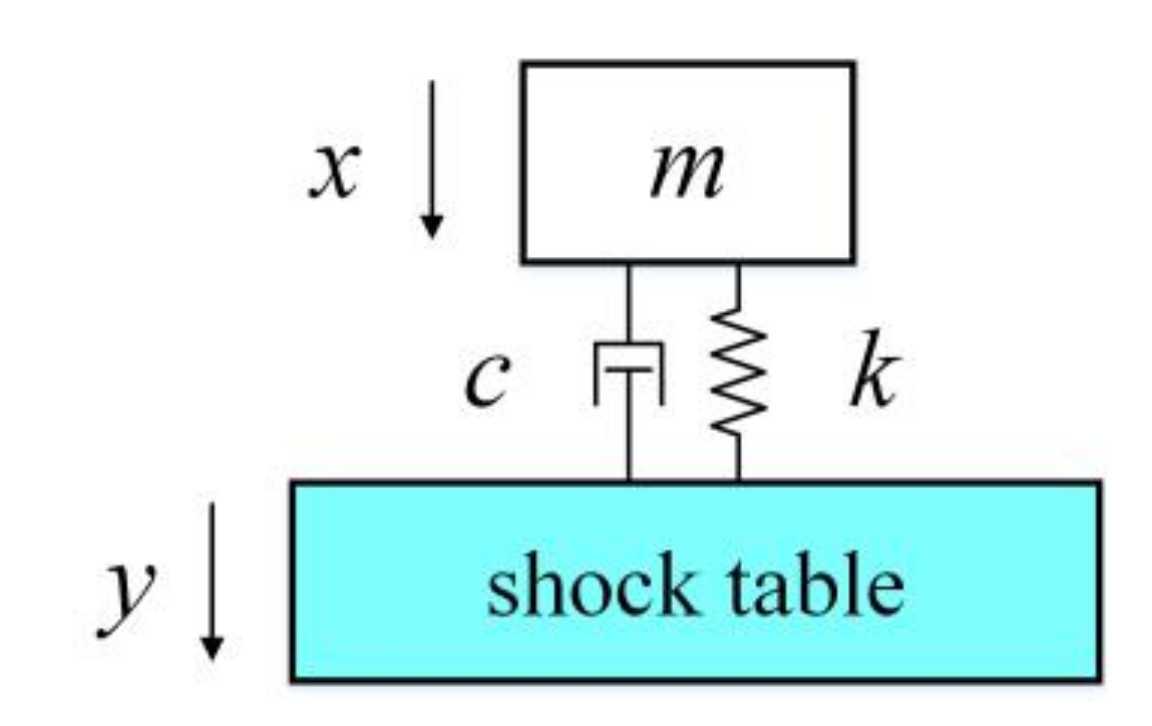
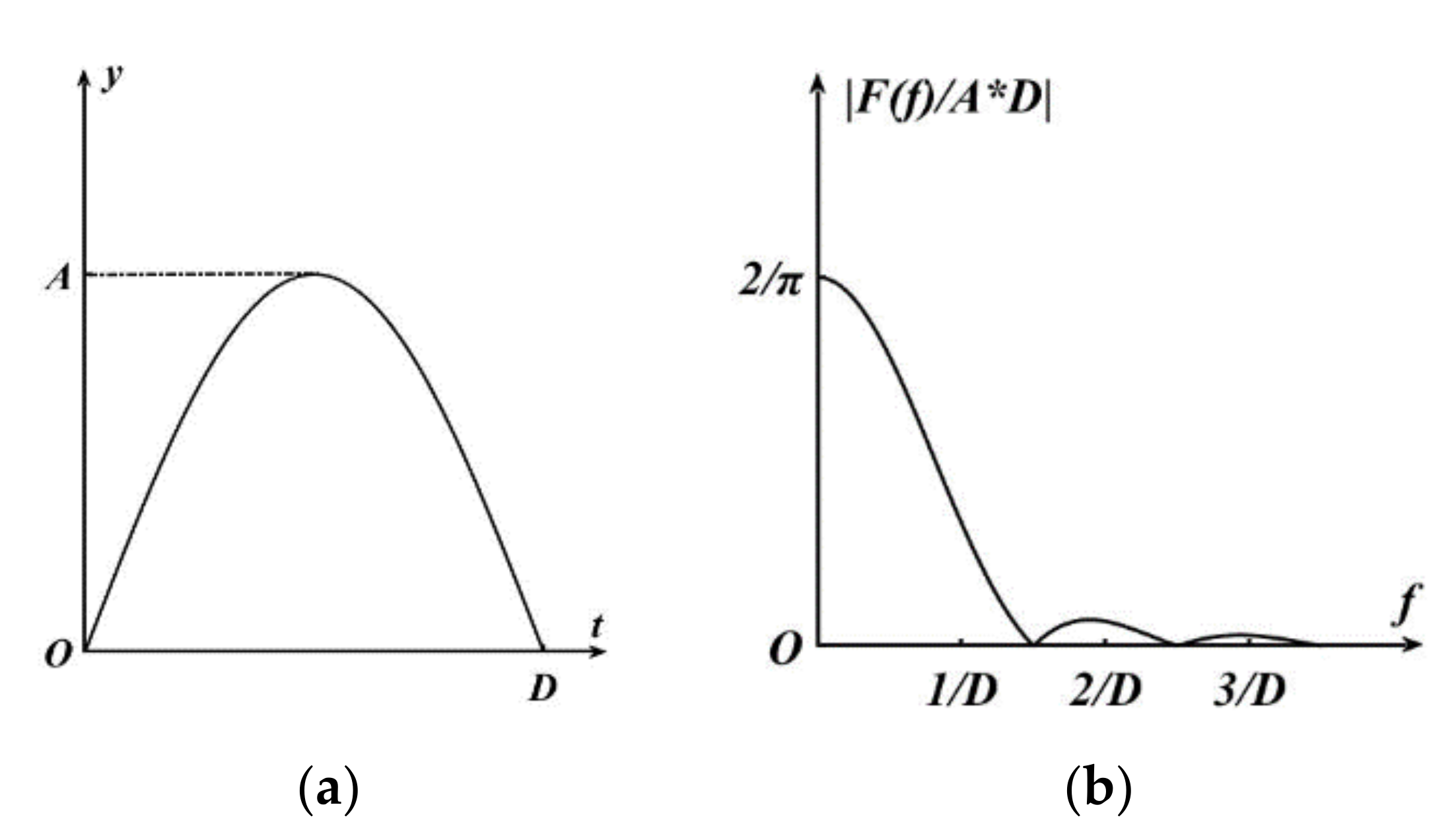
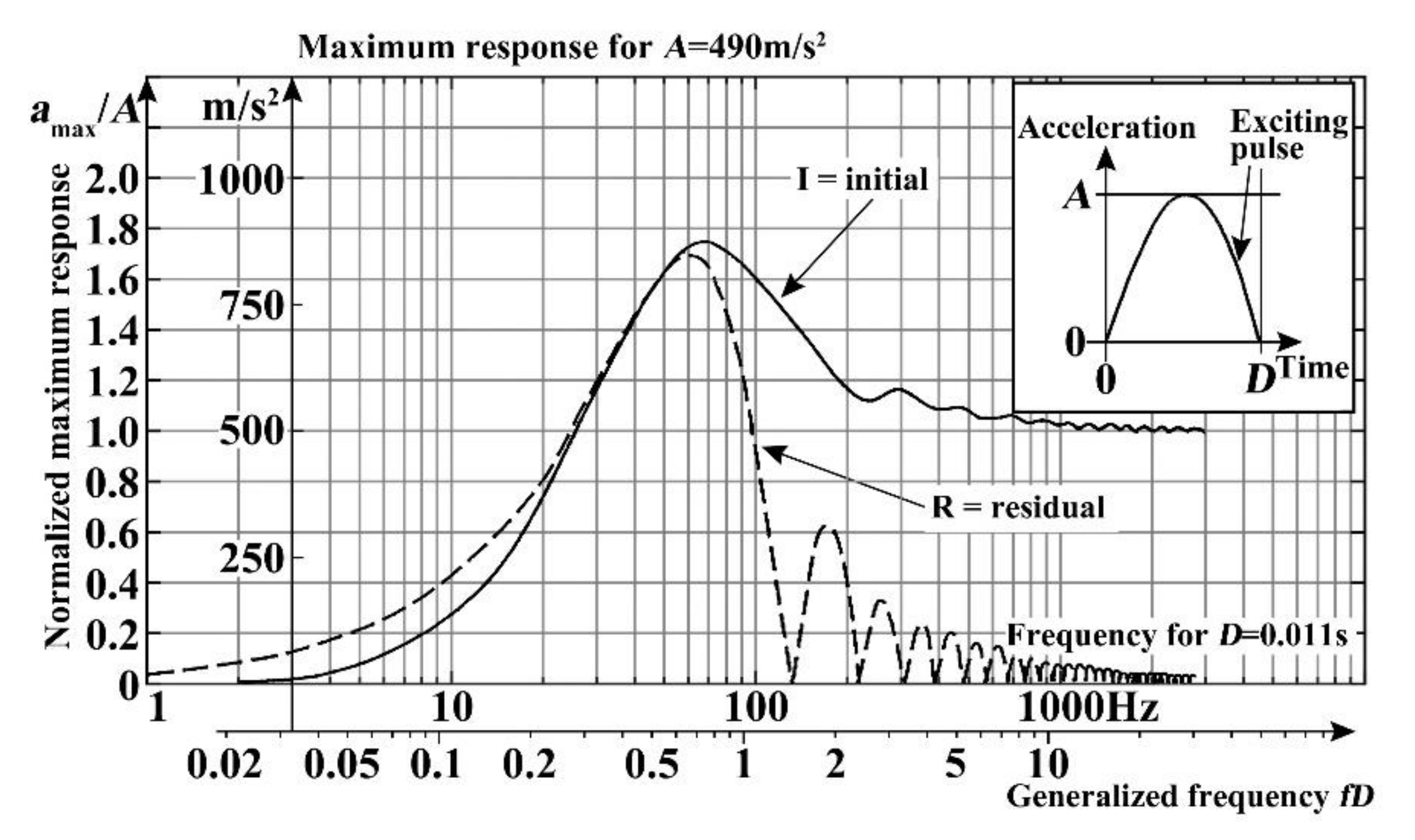

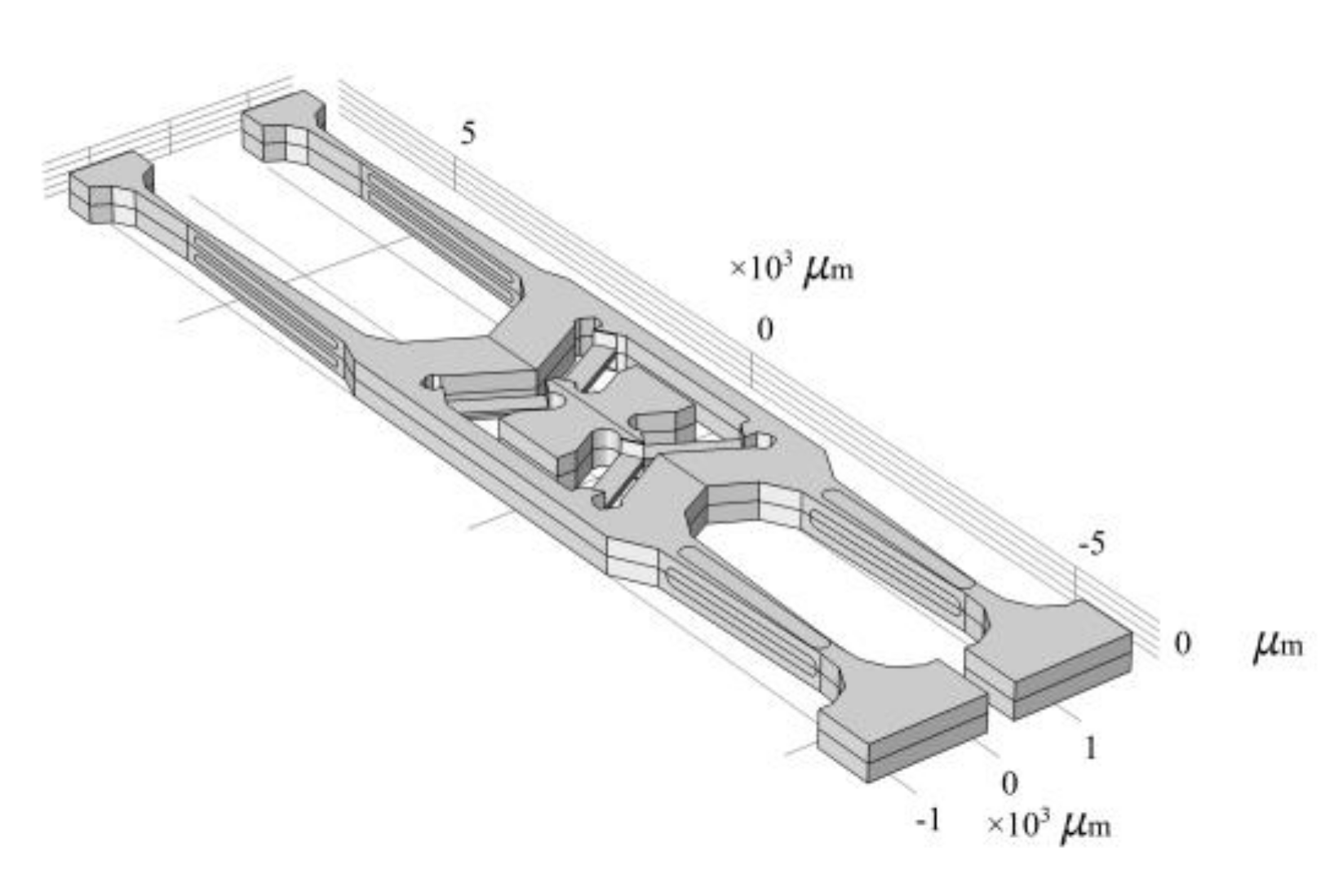
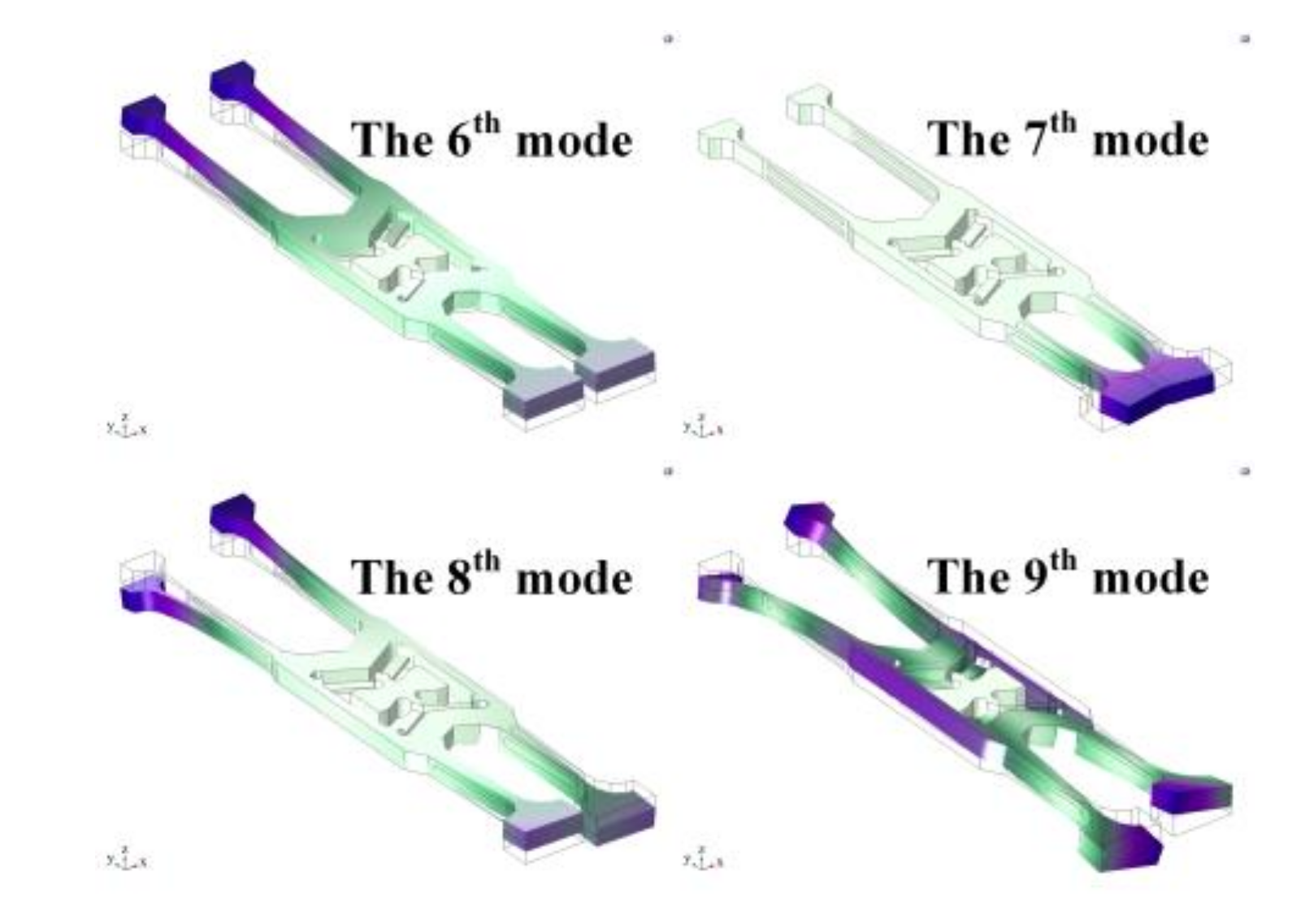

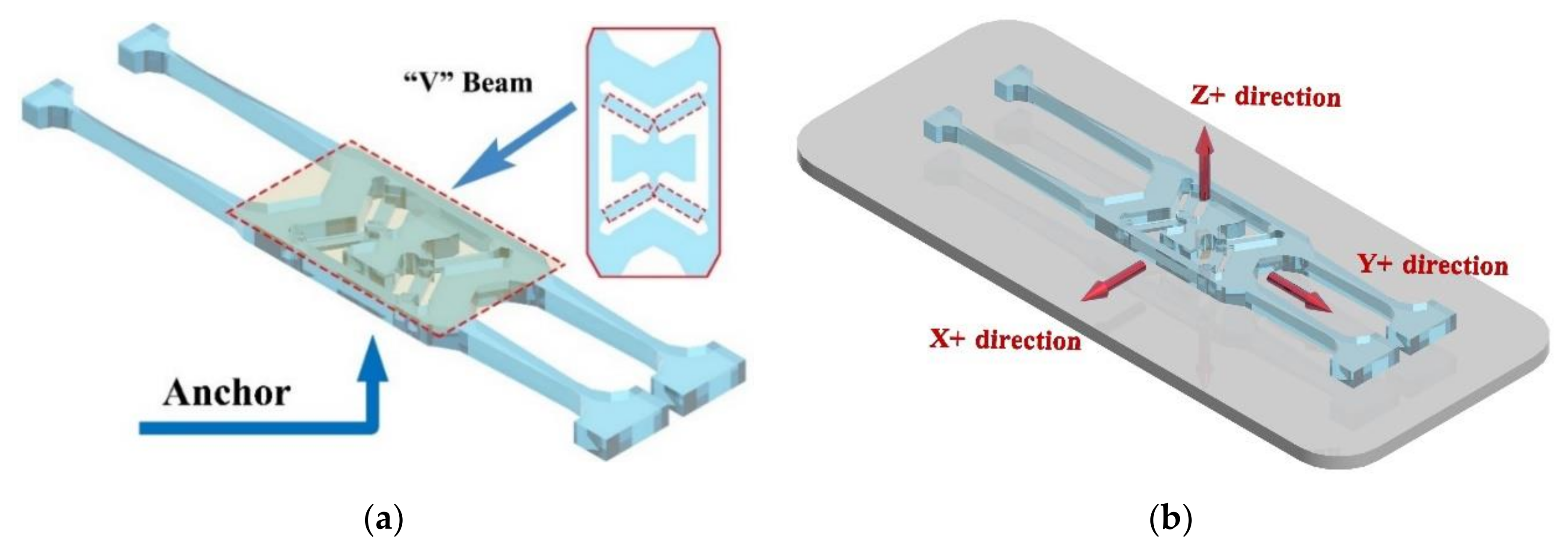
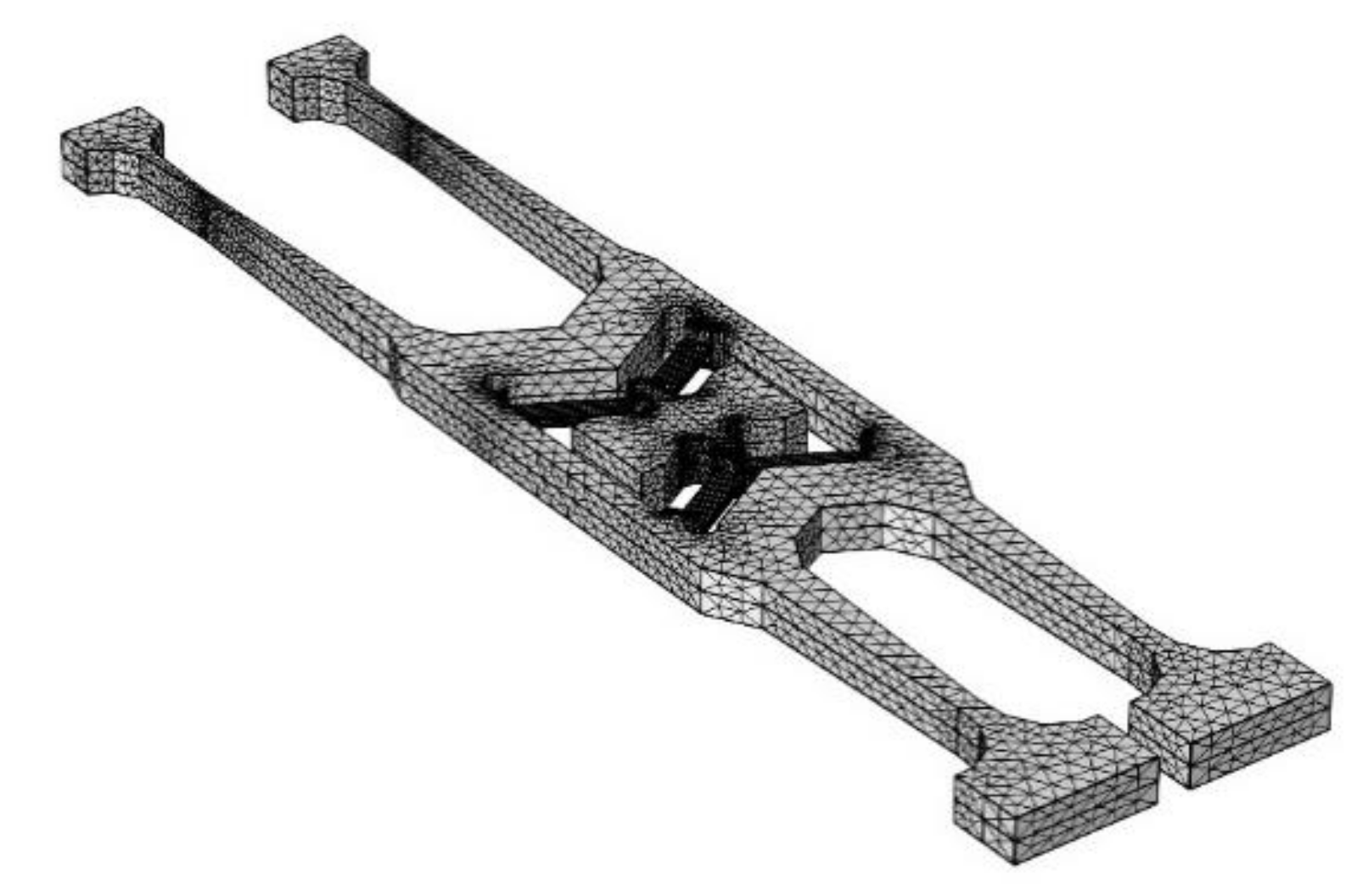

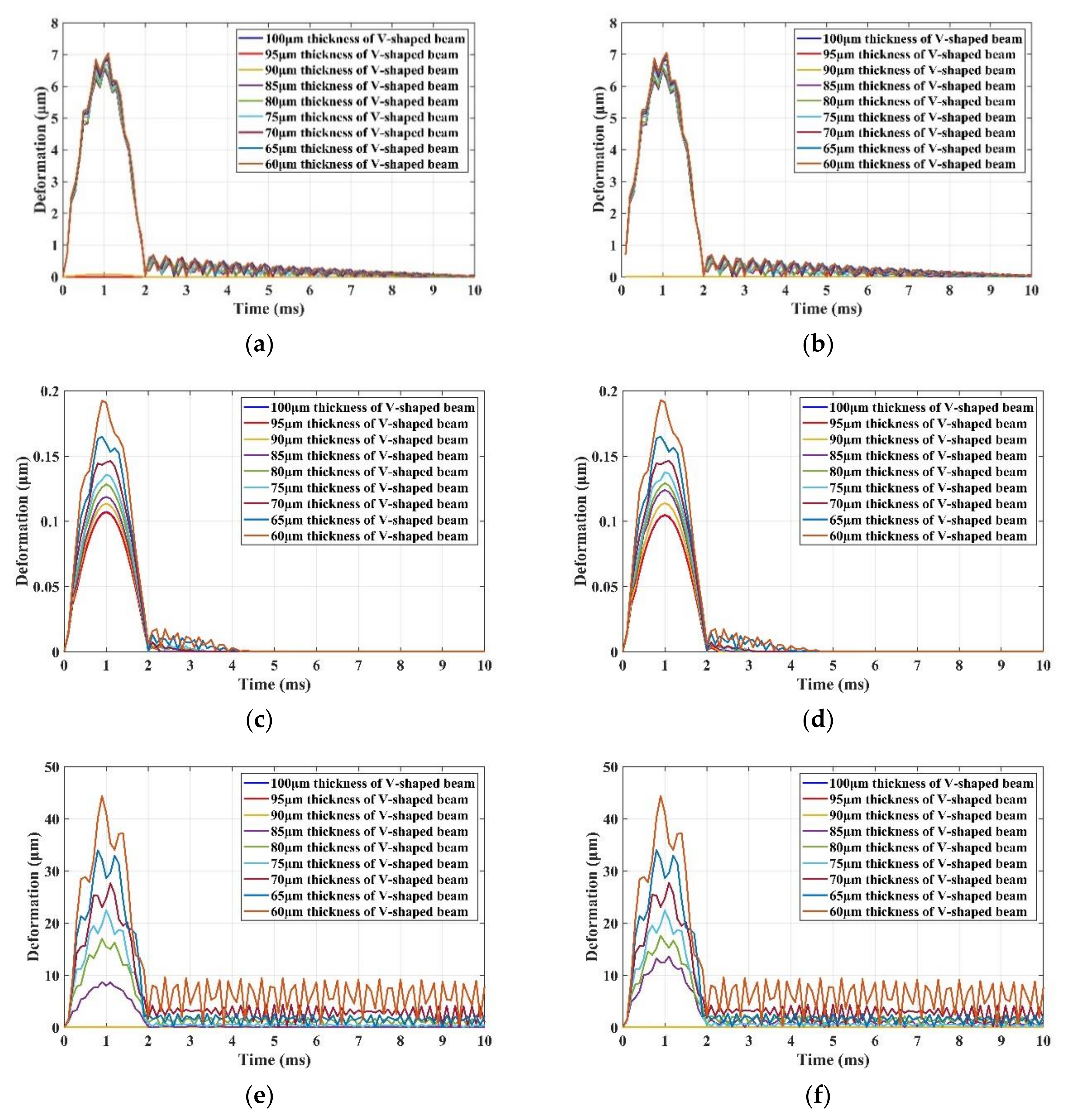
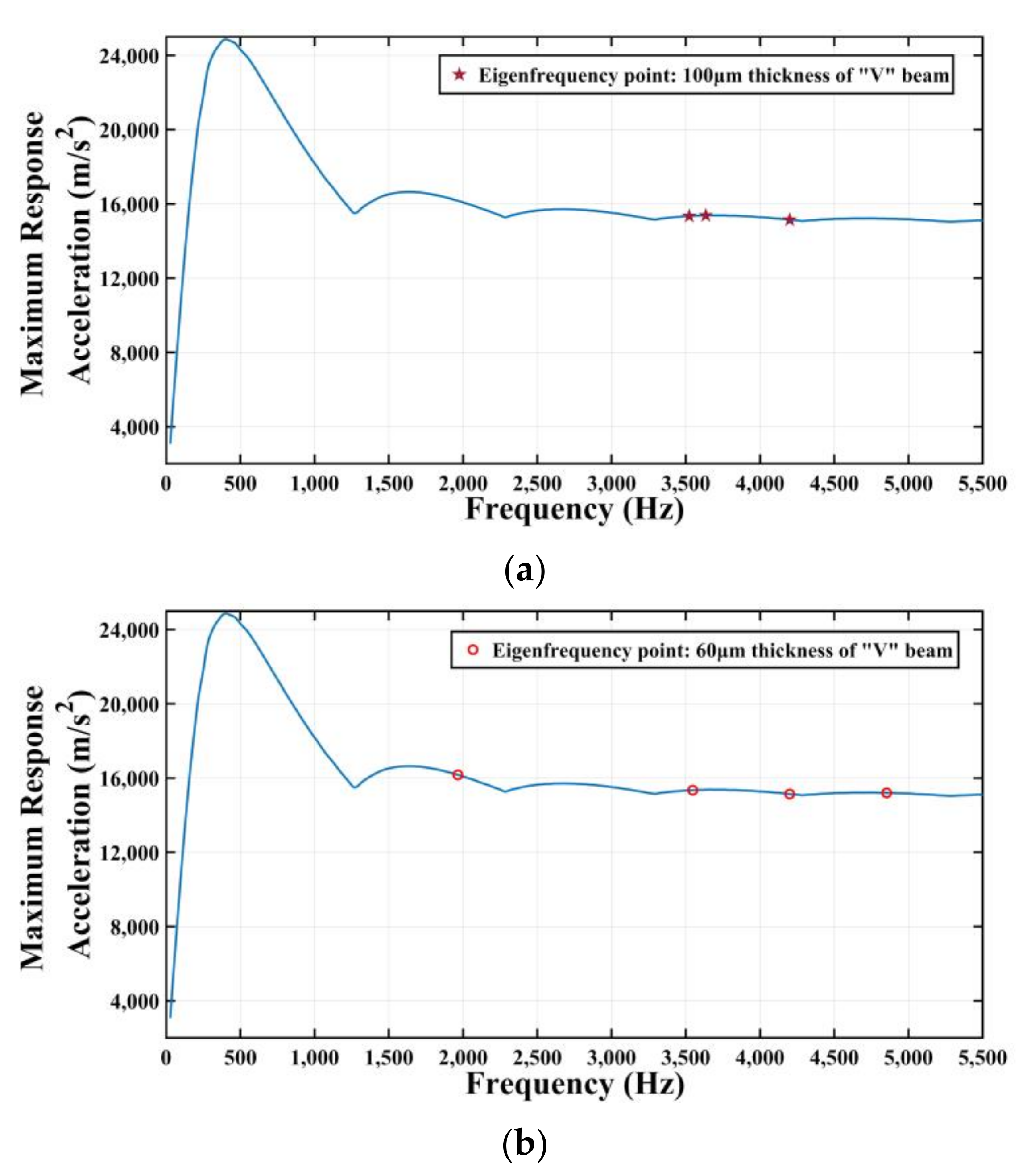
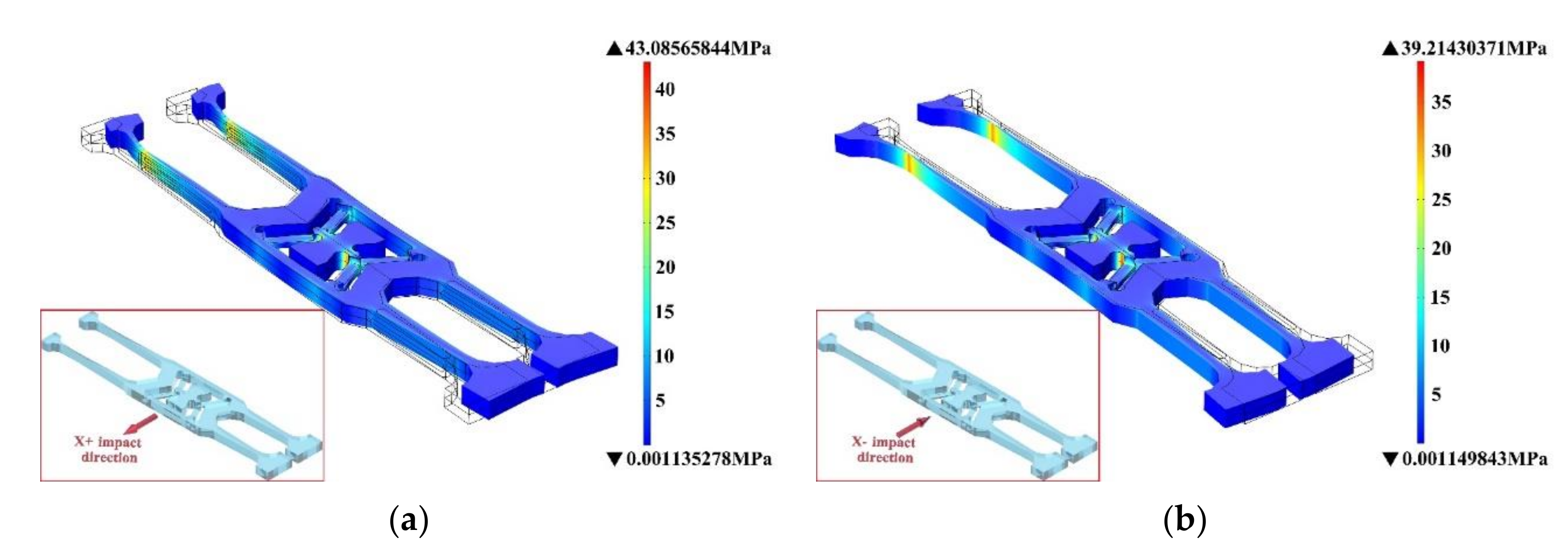
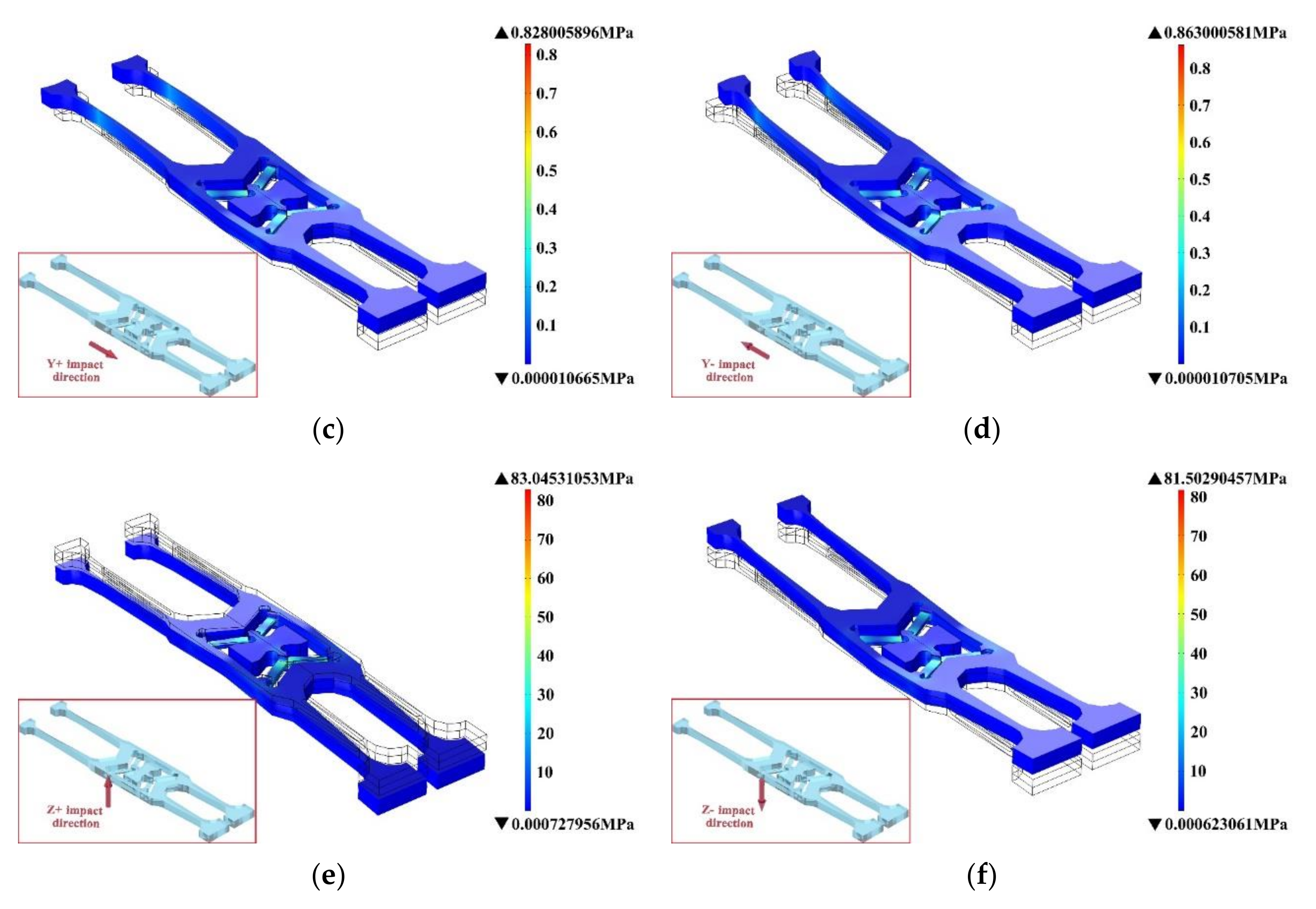
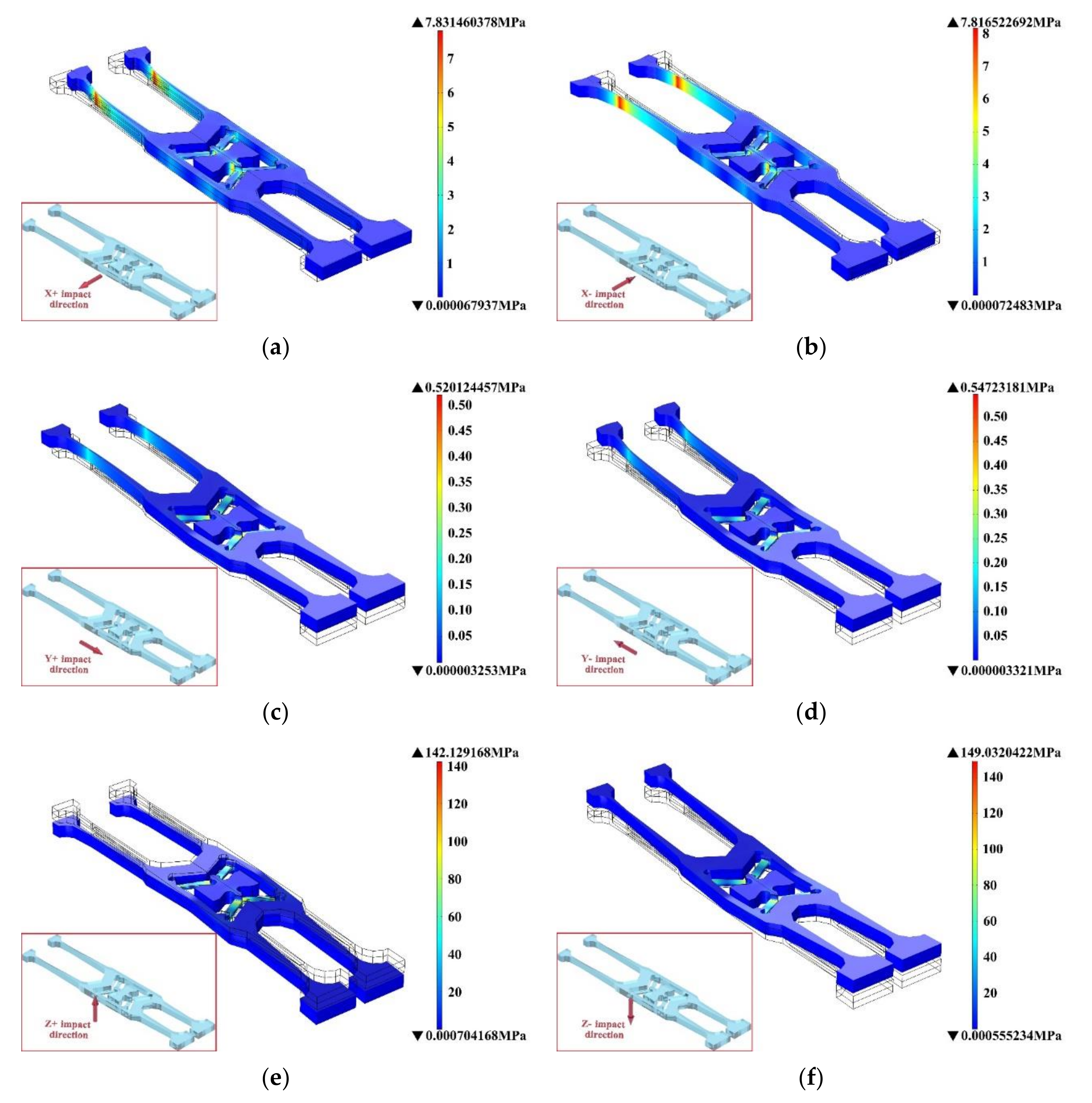
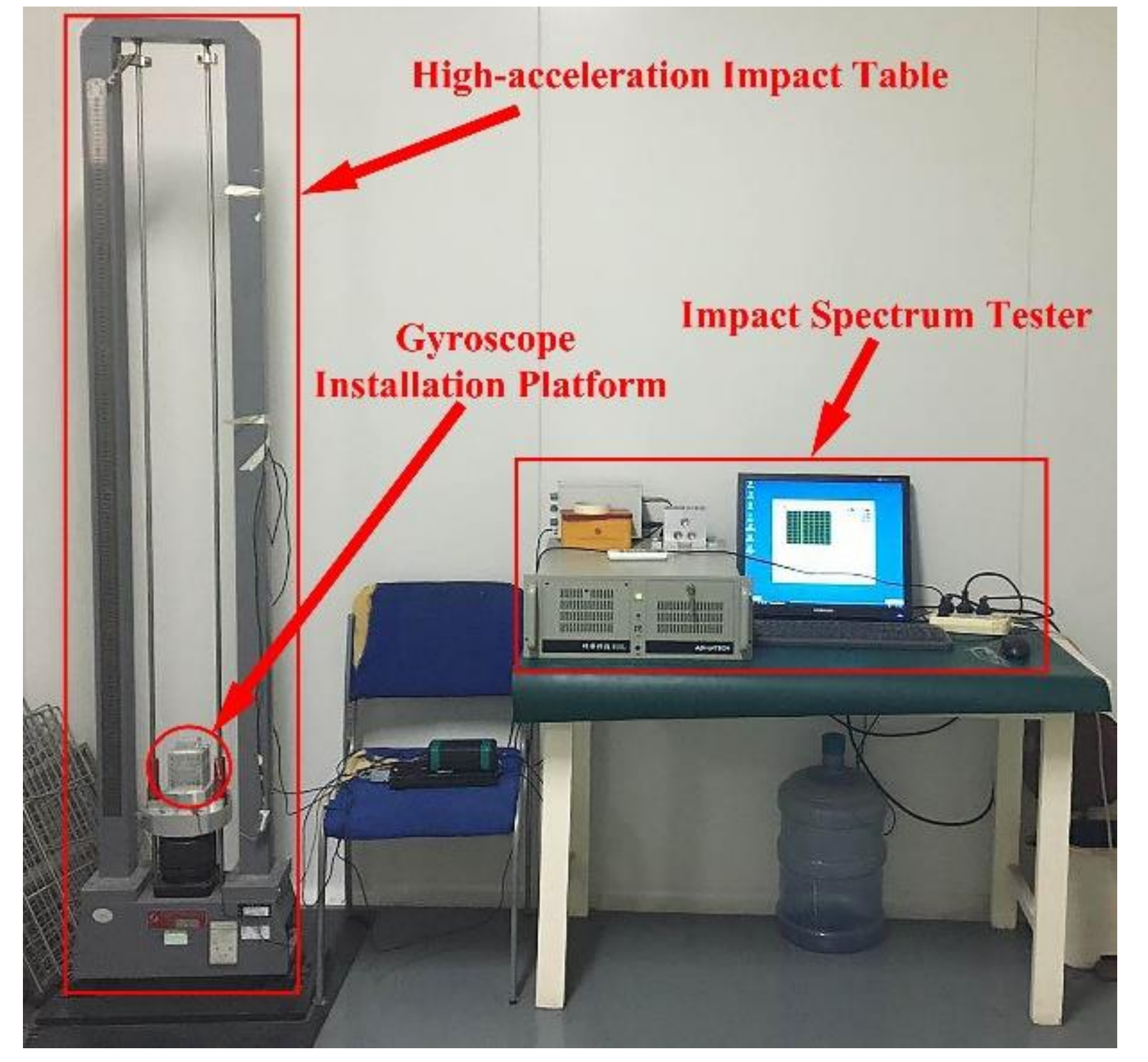
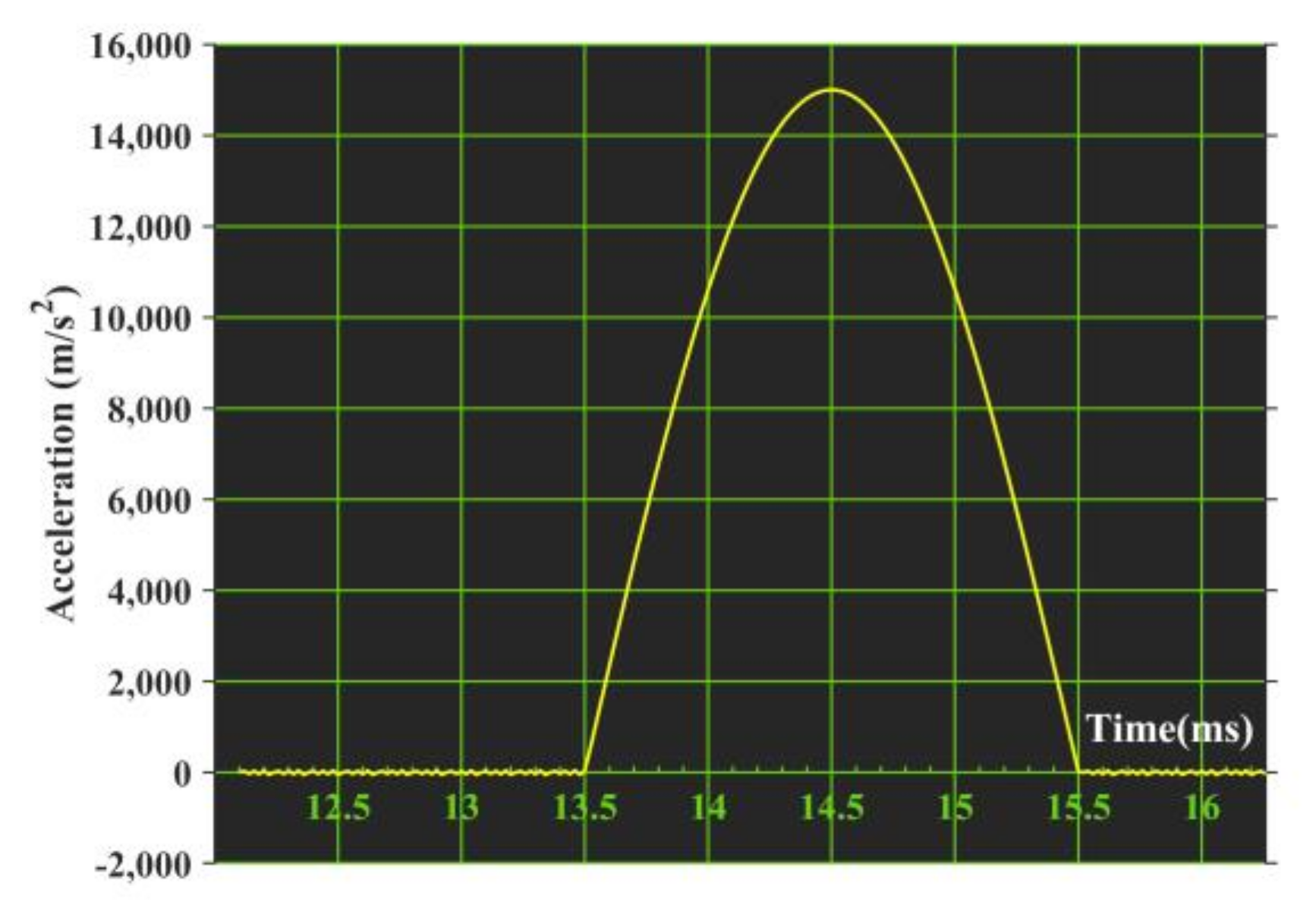
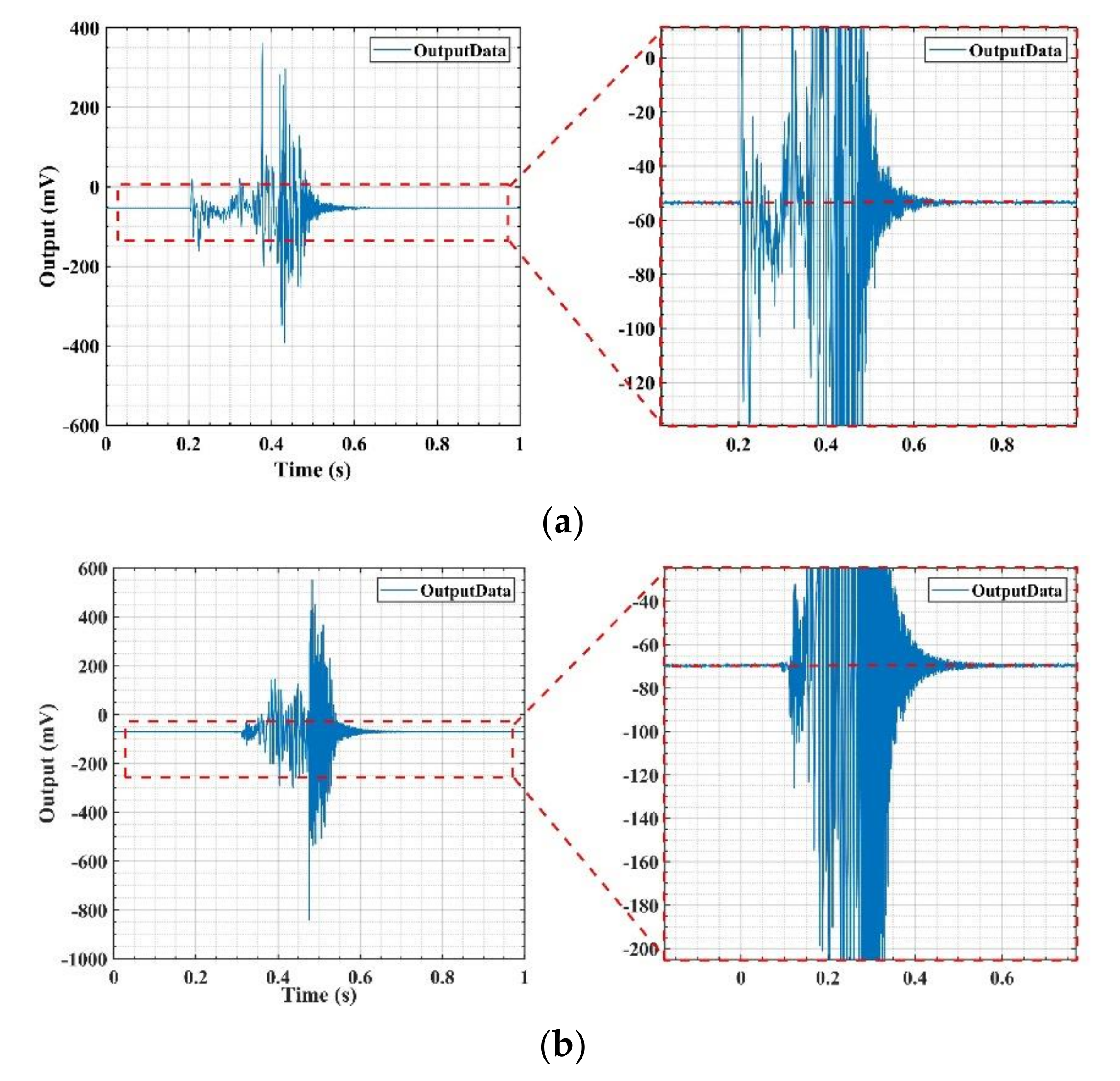
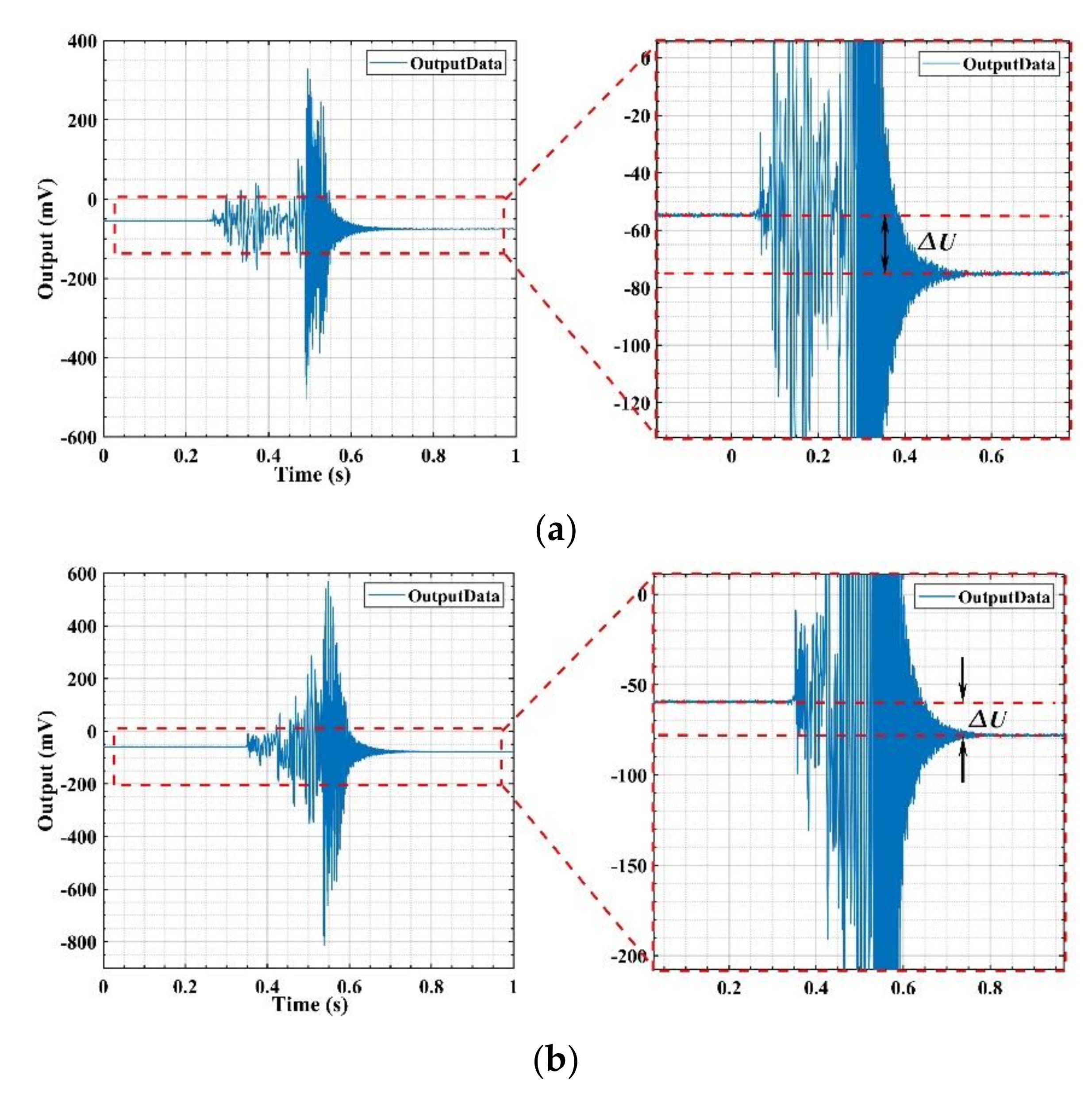
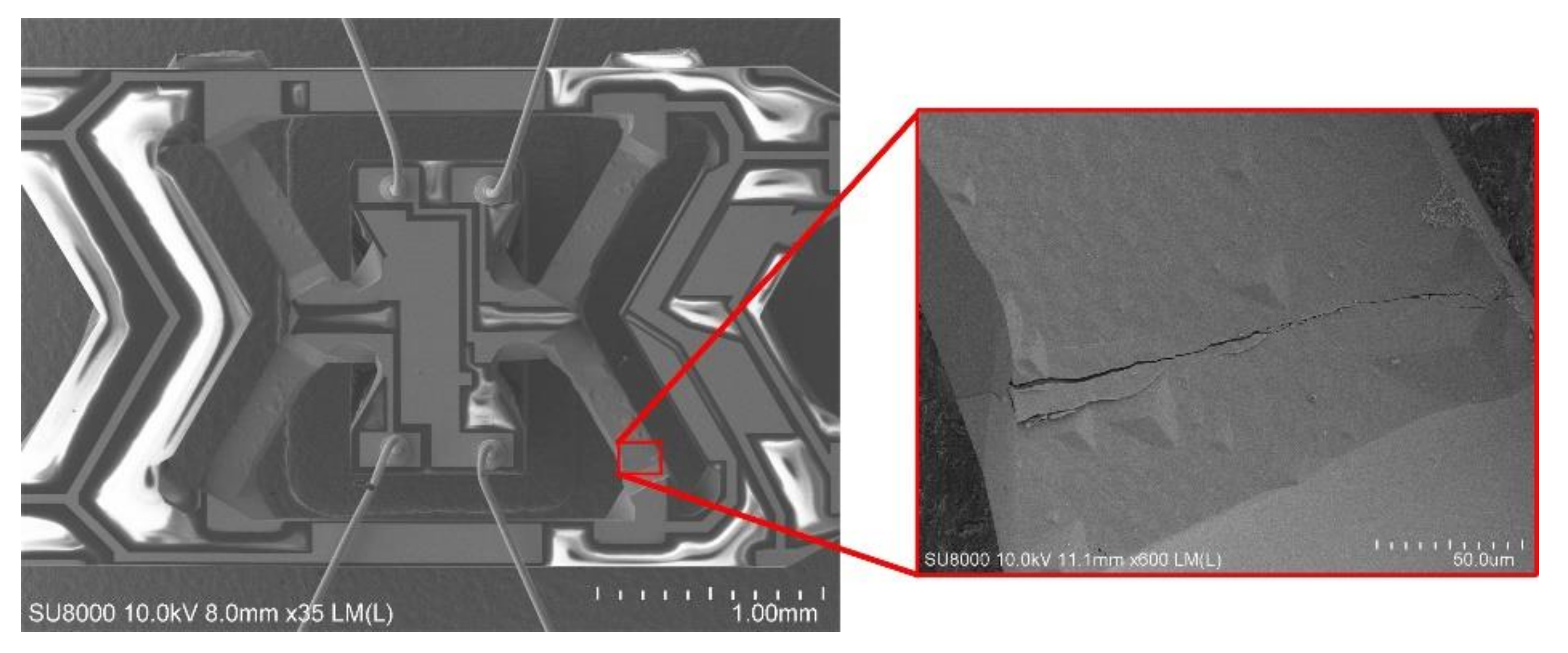
| Quantity | Symbol | Value |
|---|---|---|
| Density | ρ | 2651 (kg/m3) |
| Young’s modulus | E | 78.3 (GPa) |
| Poisson ratio | ν | 0.14 |
| Compliance matrix | 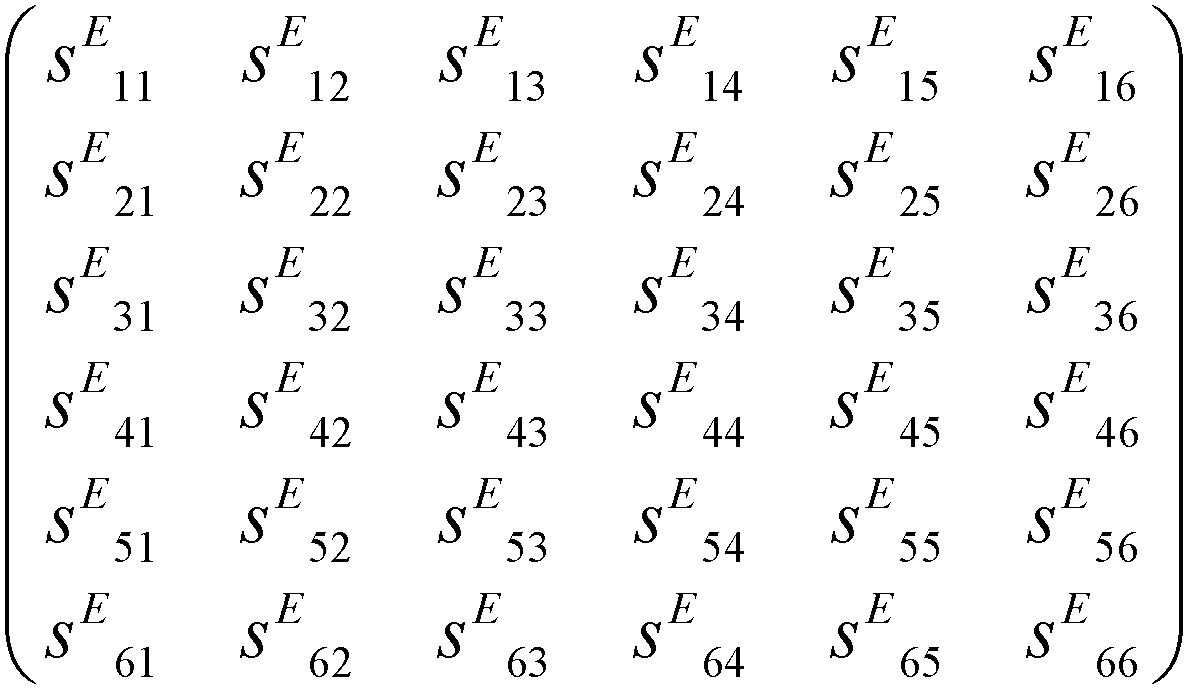 |
| Modal | The Natural Frequency of the Structure with Different V-Shaped Beam Thicknesses (Hz) | ||||||||
|---|---|---|---|---|---|---|---|---|---|
| 100 μm | 95 μm | 90 μm | 85 μm | 80 μm | 75 μm | 70 μm | 65 μm | 60 μm | |
| 1st | 3523.2 | 3348.8 | 3169.1 | 2981.8 | 2787.7 | 2588.3 | 2383 | 2174.4 | 1965.1 |
| 2nd | 3634.6 | 3626.8 | 3618 | 3608.9 | 3598.9 | 3587.8 | 3575.4 | 3561.7 | 3546.8 |
| 3rd | 4199.6 | 4199.6 | 4199.6 | 4199.5 | 4199.5 | 4199.5 | 4199.4 | 4199.4 | 4199.4 |
| 4th | 5933 | 5917.3 | 5900.3 | 5883 | 5864.6 | 5844.5 | 5820.8 | 5344 | 4852.9 |
| The Thickness of V-Shaped Beam (μm) | The Maximum Stress Value Generated by Six Shock Directions (MPa) | |||||
|---|---|---|---|---|---|---|
| X+ Direction | X– Direction | Y+ Direction | Y− Direction | Z+ Direction | Z− Direction | |
| 100 | 43.0857 | 39.2143 | 0.8280 | 0.8630 | 83.0453 | 81.5029 |
| 95 | 41.6550 | 39.1881 | 0.8264 | 0.7865 | 83.1088 | 84.3100 |
| 90 | 35.8839 | 39.5759 | 0.7280 | 0.7478 | 86.8901 | 86.1178 |
| 85 | 38.5236 | 38.4510 | 0.7376 | 0.7353 | 93.0485 | 93.0750 |
| 80 | 35.6123 | 37.9682 | 0.6950 | 0.7007 | 94.1470 | 94.7207 |
| 75 | 40.8235 | 39.2736 | 0.6337 | 0.6234 | 102.0094 | 100.5120 |
| 70 | 53.9320 | 50.8894 | 0.5912 | 0.5910 | 114.2333 | 114.2545 |
| 65 | 8.1650 | 8.1667 | 0.5824 | 0.5684 | 129.8858 | 127.5013 |
| 60 | 7.8315 | 7.8165 | 0.5201 | 0.5472 | 142.1292 | 149.0320 |
| Type | Shock Resistance | |
|---|---|---|
| BEI Systron Donner | QRS11 | 200 g, ½ sine pulse |
| QRS28 | 300 g, 5 ms, ½ sine pulse | |
| QRS2000 | 400 g, 2 ms, ½ sine pulse | |
| QRS14 | 200 g, ½ sine pulse | |
| SDG1400 | 200 g, 2 ms, ½ sine pulse | |
| QRS116 | 1000 g, 2 ms, ½ sine pulse | |
| Watson Industries | ADS–C132 | 500 g, 10 ms, ½ sine pulse |
| ADS–C232 | ||
| ARS–G152 | ||
| Our Gyroscope | – | 1500 g, 2 ms, ½ sine pulse |
Publisher’s Note: MDPI stays neutral with regard to jurisdictional claims in published maps and institutional affiliations. |
© 2020 by the authors. Licensee MDPI, Basel, Switzerland. This article is an open access article distributed under the terms and conditions of the Creative Commons Attribution (CC BY) license (http://creativecommons.org/licenses/by/4.0/).
Share and Cite
Bai, B.; Li, C.; Zhao, Y. Development of V-Shaped Beam on the Shock Resistance and Driving Frequency of Micro Quartz Tuning Forks Resonant Gyroscope. Micromachines 2020, 11, 1012. https://doi.org/10.3390/mi11111012
Bai B, Li C, Zhao Y. Development of V-Shaped Beam on the Shock Resistance and Driving Frequency of Micro Quartz Tuning Forks Resonant Gyroscope. Micromachines. 2020; 11(11):1012. https://doi.org/10.3390/mi11111012
Chicago/Turabian StyleBai, Bing, Cun Li, and Yulong Zhao. 2020. "Development of V-Shaped Beam on the Shock Resistance and Driving Frequency of Micro Quartz Tuning Forks Resonant Gyroscope" Micromachines 11, no. 11: 1012. https://doi.org/10.3390/mi11111012





